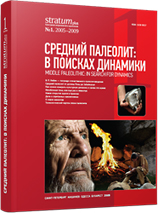О ловле мамонтов и не только
On mammoth trapping and not only about it
Author(s): Vladimir V. PitulkoSubject(s): History, Archaeology
Published by: Издательский дом Stratum, Университет «Высшая антропологическая школа»
Keywords: Palaeolithic sites; mammoth remains; Eurasia; mammoth hunting;
Summary/Abstract: There are many Palaeolithic sites extremely rich in mammoth remains all over Eurasia. At the same time, we have almost no hard evidence of mammoth hunting, except single examples of stone artifacts stuck in mammoth bones. Equally poor is our knowledge of the methods which could have been used by our Palaeolithic ancestors to hunt such a big animal as the mammoth. When discussing possible ways of mammoth hunting, archaeologists normally consider only “active” methods. However, there is a number of “passive” hunting tricks which could have been used to catch mammoth. “Pit traps” might have been of some use in the south, but it is hard to imagine how people would dig them in the permafrost soils of Northern Eurasia. There must have been some other methods of passive hunting (i.e. trapping), including those based on the use of traps made of perishable substances. There are grounds to believe that mammoths were usually hunted in cold seasons (otherwise it would be difficult to keep massy food supplies fresh long enough, move meat from kill sites to camps, and protect it), and it is probably no mere chance for a chronological coincidence of the beginning of the regular mammoth hunting with the onset of the last glaciation. It can be hypothesized also that the former process was triggered by a technological breakthrough, which opened the possibility to use woven materials for manufacturing trapping equipment.
Journal: Stratum plus. Археология и культурная антропология
- Issue Year: 2009
- Issue No: 1
- Page Range: 288-299
- Page Count: 12
- Language: Russian
- Content File-PDF

